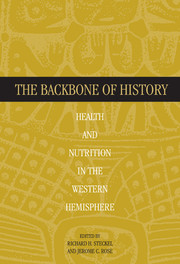Book contents
- Frontmatter
- Contents
- Preface
- List of Contributors
- PART I
- PART II METHODOLOGY
- 2 Reconstructing Health Profiles from Skeletal Remains
- 3 A Health Index from Skeletal Remains
- 4 Paleodemography of the Americas: From Ancient Times to Colonialism and Beyond
- PART III EURO-AMERICANS AND AFRICAN-AMERICANS IN NORTH AMERICA
- PART IV NATIVE AMERICANS IN CENTRAL AMERICA
- PART V NATIVE AMERICANS AND EURO-AMERICANS IN SOUTH AMERICA
- PART VI NATIVE AMERICANS IN NORTH AMERICA
- PART VII
- PART VIII
- PART IX EPILOGUE
- Index
4 - Paleodemography of the Americas: From Ancient Times to Colonialism and Beyond
Published online by Cambridge University Press: 01 March 2010
- Frontmatter
- Contents
- Preface
- List of Contributors
- PART I
- PART II METHODOLOGY
- 2 Reconstructing Health Profiles from Skeletal Remains
- 3 A Health Index from Skeletal Remains
- 4 Paleodemography of the Americas: From Ancient Times to Colonialism and Beyond
- PART III EURO-AMERICANS AND AFRICAN-AMERICANS IN NORTH AMERICA
- PART IV NATIVE AMERICANS IN CENTRAL AMERICA
- PART V NATIVE AMERICANS AND EURO-AMERICANS IN SOUTH AMERICA
- PART VI NATIVE AMERICANS IN NORTH AMERICA
- PART VII
- PART VIII
- PART IX EPILOGUE
- Index
Summary
ABSTRACT
Great variations in fertility constitute one of the major findings of this project to our knowledge of the demography of the past. In the Ancient Americas (that is, more than 1,500 years ago), fertility seems to have been surprisingly low (gross reproduction ratio, GRR, = 2.3), and the brake on explosive population growth was fertility rather than mortality (life expectancy at birth, e0, = 34 years). Consequently, the ancient demographic regime was a relatively low-pressure system. A high-pressure system of high fertility and high mortality dates from the middle period, 1500 bp–500 bp (before the present). Characteristic of only simple horticulturists in ancient times, a high-pressure demographic regime seems to have become more general during the middle period, intrinsic to both complex agrarian systems as well as foragers and fishers (GRR = 3.0 and 2.8, respectively). Agriculture was not the engine of demographic transformation in prehistoric America because nonhorticulturists also experienced a substantial rise in fertility. A second great demographic transformation began 500 years ago with the intrusion of Old World populations and technologies. While these changes were sweeping, indeed many peoples were thrust to the verge of extinction, the fundamental demography of the survivors did not change greatly. The old demographic regime persisted into the nineteenth century, if the picture developed here from the osteological evidence is trustworthy. Likewise, African–American demographic systems seem to have been under high pressure: very high fertility and high mortality, with the highest pressures characteristic of the free. European–American demographic systems, as measured here, were decidedly low pressure, with relatively moderate mortality and moderately higher fertility.
- Type
- Chapter
- Information
- The Backbone of HistoryHealth and Nutrition in the Western Hemisphere, pp. 94 - 124Publisher: Cambridge University PressPrint publication year: 2002
- 14
- Cited by



